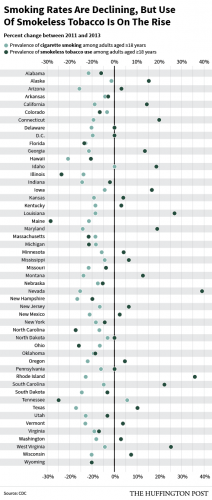Source: www.huffingtonpost.com
Author: Anna Almendrala
First, the good news: Smoking rates are down significantly in 26 states. The bad news? The use of smokeless tobacco (also known as dip, snuff or chew) is up in four states, while using both cigarettes and smokeless tobacco is up significantly in five states.
“Although overall cigarette smoking prevalence has declined significantly in recent years in many states, the overall use of smokeless tobacco and concurrent cigarette and smokeless tobacco has remained unchanged in most states and increased in some states,” summed up researchers for the Centers for Disease Control, which published the data in their weekly Morbidity and Mortality report.
From 2011 to 2013, four states showed increased smokeless tobacco use: Louisiana, Montana, South Carolina and West Virginia. Only two states — Ohio and Tennessee — exhibited decreases. In terms of total use, Massachusetts and the District of Columbia reported the lowest numbers of smokeless tobacco, at 1.5 percent, in 2013. In contrast, West Virginia reported the highest use, at 9.4 percent, with Wyoming and Montana coming in second and third, at 8.8 percent and 8 percent, respectively.
Breaking down tobacco use by state helps health officials create more targeted state and local tobacco policies, explained CDC researcher Kimberly Nguyen in an email to HuffPost.
“It’s important to note that the states with lower tobacco use prevalence typically have more robust tobacco control programs and greater adoption of evidence-based population level interventions,” she wrote.
The findings are significant because past research has shown that people using both products are more addicted to nicotine and less likely to want to quit both habits than those who just smoke cigarettes. It also suggests that the public may have misperceptions about the safety of smokeless tobacco — namely, that it is a safer alternative to cigarettes — thanks to advertising campaigns.
The findings are significant because past research has shown that people using both products are more addicted to nicotine and less likely to want to quit both habits than those who just smoke cigarettes. It also suggests that the public may have misperceptions about the safety of smokeless tobacco — namely, that it is a safer alternative to cigarettes — thanks to advertising campaigns.
In reality, smokeless tobacco is addictive because of the nicotine it contains, and it can cause oral, esophageal and pancreatic cancer, according to the NIH’s National Cancer Institute. It may also cause other diseases like gum disease, oral lesions and precancerous patches in the mouth called leukoplakia. In no way should it be considered an aid to help people quit smoking, notes the NCI.
“Smokeless tobacco use can also increase risks for early delivery and stillbirth when used during pregnancy, cause nicotine poisoning in children, and may increase the risk for death from heart disease and stroke,” Nguyen added. “Smokeless tobacco is not a safe alternative to smoking.”
The CDC researchers aren’t sure why smokeless tobacco use is going up, but the report notes a few possible reasons.
“These increases could be attributable to increases in marketing of smokeless tobacco, the misperception that smokeless tobacco is a safe alternative to cigarettes, and the lower price of smokeless tobacco products relative to cigarettes in most states,” wrote the researchers. “In addition, the tobacco industry has marketed smokeless tobacco as an alternative in areas where smoking is otherwise prohibited.”
Just last month, the Food & Drug Administration rejected tobacco producer Swedish Match AB’s request to remove cancer warnings from their smokeless tobacco product, Snus, and replace the warnings with the claim that it is safer than cigarettes. And last week, the FDA also rejected a petition from R.J. Reynolds Tobacco Company and American Snuff Company to similarly alter the labels on their smokeless products.
To combat rising rates of smokeless tobacco use, the CDC recommend that states increase their spending on anti-tobacco programs, which include increasing the price on products, restricting tobacco advertising, increasing anti-tobacco graphics and commercials, and helping users quit their addictions. Indeed, while states will bring in more than $25 billion in settlement payments and tobacco taxes in 2015, they’re also projected to spend less than two percent of that revenue on such programs — much less than the CDC-recommended levels for each state.


Leave A Comment
You must be logged in to post a comment.